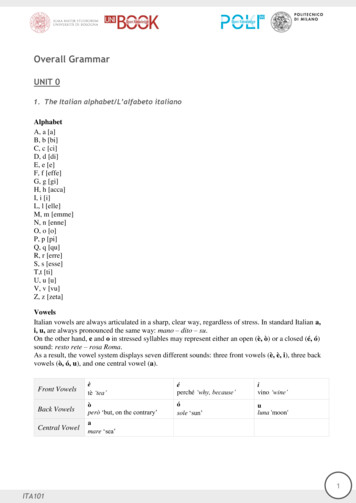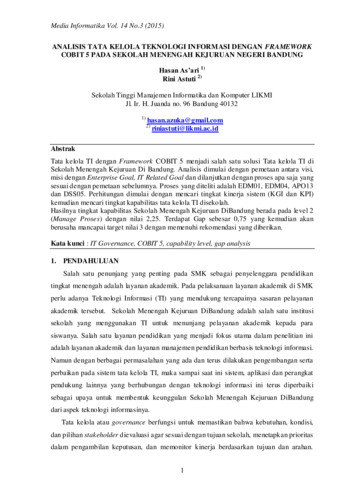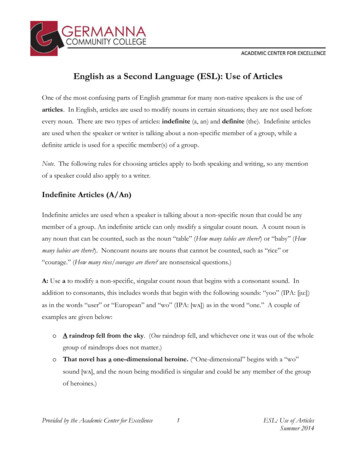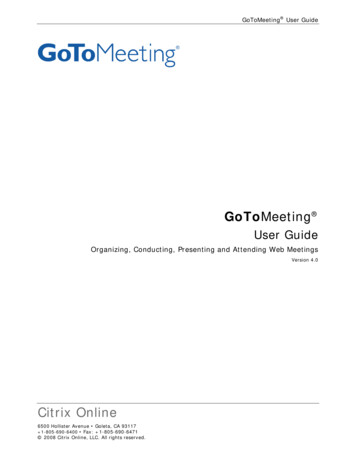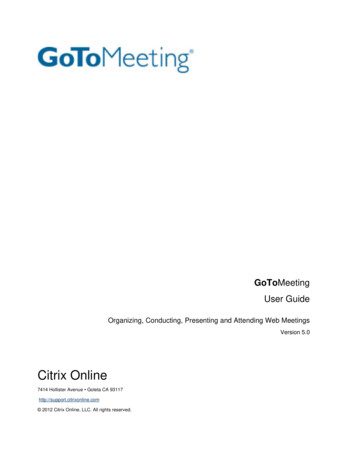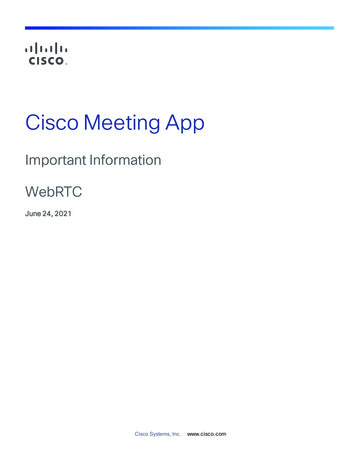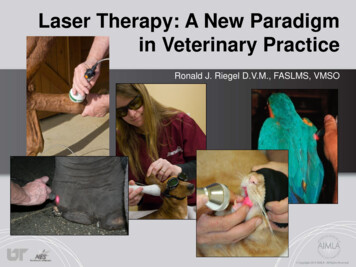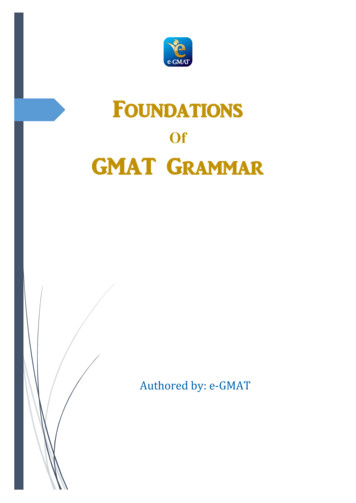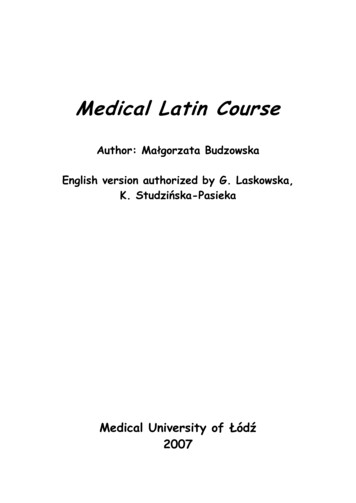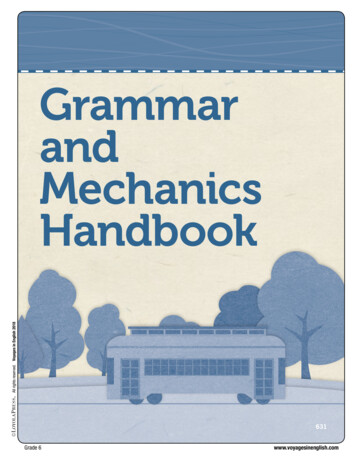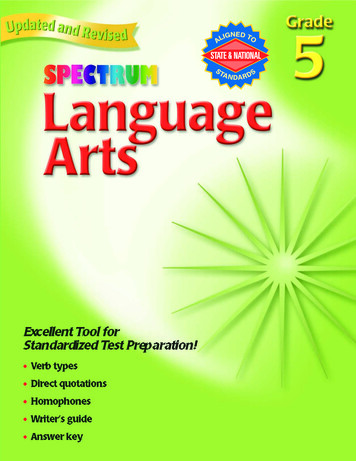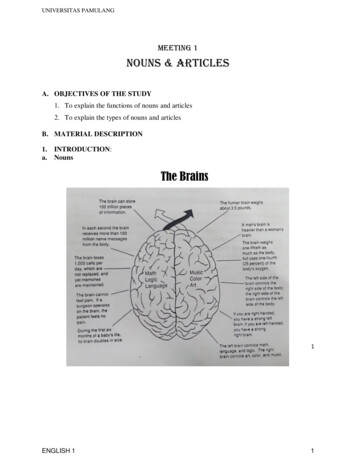
Transcription
UNIVERSITAS PAMULANGMeeting 1NOUNS & ArticlesA. OBJECTIVES OF THE STUDY1. To explain the functions of nouns and articles2. To explain the types of nouns and articlesB. MATERIAL DESCRIPTION1.a.INTRODUCTION:NounsThe Brains1ENGLISH 11
UNIVERSITAS PAMULANGExercise 1:Nouns are tested on the TOEFL test. Complete these sentences with nouns.1. The brain stores 100 trillion pieces of .2. Men’s brains are heavier than .brains.3. The brain uses one-quarter, or .of the body’s program.4. The left brain controls math, ., and .5. The right brain controls color, ., and .6. The human brain weighs about 3.5 .7. The brain cannot feel .8. The brain receives more than 100 . .messages from the bodyExercise 2:From the reading work out whether statements are true or false. Check T for True and Ffor False.1. The weight of the brain depends on intelligence.TF2. A jazz musician has a dominant right brain.TF3. A left handed person has a dominant left brainTF4. When you play a game of chess you use the left side of your brain TF5. Your lost brain cells are always replacedTF6. The brain feels pain when you have a new headacheTFb. ArticlesISLANDSSome islands were originally parts of the continents. These islands were separatedfrom the mainland as a result of a rise in sea level. For example, Great Britain wasconnected to the mainland of Europe about 11,000 years ago. As the climate got warmer,ice melted and the sea level rose. As a result, water covered the land that had connectedGreat Britain to the mainland.Other islands rise from the ocean. Some are volcanoes, such as the island of Hawaiiand the island of Japan. Some volcanic islands are millions of years old, but new islandsare forming all the time. For example, Iceland was formed millions of years ago byvolcano. In 1963, a volcano started to form a new island called Surtsey near Iceland.Islands differ greatly in size. Greenland is the largest island in the world. Thedifference size of Greenland, geographers classify Australia as a continent.ENGLISH 12
UNIVERSITAS PAMULANGExercise 3: Complete the sentences with the name of the country or island.1.2.3.4.5.6.Honshu is the biggest island in . .is the biggest island in the world.According to the geographers, .is not an island, but a continent.About 11,000 years ago .was connected to Europe. .was formed by a volcano millions of years ago. .is a new island formed in 1963.Exercise 4: Complete the sentences below with information from the cart1.2.3.4.5.6.2.Greenland is the largest island. It is in the .ocean. .is the second largest island. It is in the .ocean. .is . .largest island. It is in . Ocean. .is . .largest island. It is in .Ocean. .is . .fifth largest island. It is in . Ocean. .is . .largest island. It is in . Ocean.GRAMMARS:a) NOUNSSingular and Plural NounsNouns can be classified into two groups: count nouns, which can be counted and which take an s,and non-count nouns, which cannot be counted and which usually do not take an s.STRATEGYLook for a non-count noun that is pluralized where it generally should not be.Look at the following table:Count nounNon-count nounENGLISH 1SingularA cellOne cellPluralCellsTwo cellsSome cellsA lot of cellsMany cellsInformationSome informationA lot of informationMuch information3
UNIVERSITAS PAMULANGCount nouns1. Take a/an or one for the singular.2. Usually take a final s/es in the pluralNon-count nouns1. Do not take a/an in the singular2. Do not generally have a plural form.Some count nouns are irregular and do not take an s in the plural. Here are some commonirregular count childrenfish-fishNon-count nouns cannot be counted because they come in a mass or in an uncountable form.Nouns such as blood, music, and excitement cannot be counted. The following is a short list ofsome non-count nouns:3ENGLISH 14
UNIVERSITAS PAMULANGfoodRice, sugar, fruit, milk, bread, butter, cheeseFluidsBlood, water, oil, coffee, tea, gasolineRaw materialWood, paper, glass, iron, silver, woolGasesOxygen, nitrogen, air, pollution, steamGeneralFurniture, mail, money, traffic, equipmentGroupsJewelry, machinery, luggage, clothing, cashLanguagesEnglish, Chinese, Japanese, SpanishAcademic SubjectsChemistry, mathematics, psychologyAbstract thingsEducation, freedom, health, intelligence, beauty, knowledge, sleep, time1. QUANTIFIERSA quantifier is a word that indicates an amount or quantity.a. Some quantifiers are used only with plural count nouns.b.Some quantifiers are used only with singular count nouns.c.Some quantifiers are used only with non-count nouns.The amount of oxygen available to the brain is important.If your brain gets less oxygen than it needs, you could become unconscious.d.Some quantifiers are used with both plural count nouns and non-count nouns.Allplenty ofEnoughmostanylots ofa lot ofsomemoreBrain cells use up a lot of energy.Most animals rely on instinct.4ENGLISH 15
UNIVERSITAS PAMULANGExercise 3:Correct the errors in noun forms in the following sentences.1. Intelligence is the ability to use thought and knowledges to understand things andsolve problems.2. Hormones help adjust the mixture of sugar, salt, and waters in your body.3. Psychology, meaning the study of mind and how it works, comes from a Greek wordmeaning lifes or soul.4. Brain cells use up a lot of energy, so they need a constant supply of oxygens.5. Each hemisphere of the brain receives information about the opposite side of thevisual field.6. Although millions of brain neurons are active at any one time, they do not use muchelectricity power.7. Lights entering the eye forms an image on 130 million tiny light cells.8. Most animal are able to rely on learning and memory.2. COMPOUND NOUNSSTRATEGYLook for compound nouns in which both nouns are pluralized, instead of just thesecond noun.Compound nouns are two nouns that are used together to make one word or idea.The first noun act as an adjective to the second noun and usually does not take s. Thesecond noun can be plural:Brain cellbrain wavecomputer scientistsCompound nouns may also be used with number of expression.STRATEGYBeware of compound nouns with numbers, where the compound noun used asan adjective may be in the plural form!5ENGLISH 16
UNIVERSITAS PAMULANGThe brain uses as much power as a ten-watt bulb. (noun used as an adjective)The brain uses as much power as a lightbulb of ten watts. (noun used as noun)He recited a 16,000-page book from memory. (noun used as an adjective)He recited a book of 16,000 pages from memory. (noun used as a noun)3. NUMBERSSTRATEGYWhen you see nouns involving numbers, such as hundred, thousand, million, make surethat they are not in the plural forms when they follow number.Numbers such as hundred, thousand, million, and trillion are plural when there are nonumbers before them.The brain receives 100 million messages a second.The brain stores trillions of messages.Exercise 4Correct the errors in the following sentences.1. People’s brains weigh more now than they did 100 year ago.2. Nerves impulses can travel at speeds of up to 488 feet per second.3. The brain contains between 10trillions and 100 trillions neurons.4. Each neutron is linked by synapses to thousand of other neurons.5. Nerves endings below the skin’s surface pick up sensation of cold, heat, and touch.6. There are three to four millions pain receptors in the skin.7. A three-year-old child’s brain is two-thirds the size it will finally be.8. The brain uses 25 percents of the blood’s oxygen.6ENGLISH 17
UNIVERSITAS PAMULANGb) ARTICLES1. The Indefinite Article A or AnSTRATEGYAvoid confusion between a and an. Remember, an is used before a vowel sound.Avoid confusion between a and an. Remember, an is used before a vowel sound.The indefinite article a or an is used:a) Before singular count nouns to mean one. It is not used before non-countnouns, example:Australia is a continent.b) An is used before a word that begins with a vowel sounds (a, i, u, e, o).When words begin with “h” or “u” either a or an can be used depending onthe sound:an unclea homea universityan houra unionan honorc) In a general statement:They are performing a drama.d) To introduce a subject that has not been mentioned before: I saw a snakee) With certain numerical expressions:ENGLISH 18
UNIVERSITAS PAMULANGf)a great deal a couplea hundreda thirda halfa great many a dozena lot offifty miles an hourWith names of professions:He is an engineer.She is a biologist.Exercise 5: Circle a or an in the following sentences. Write “C” on the left ifthe sentence is correct. Write “NC” if the sentence is notcorrect. Correct the error. .1. Indonesia is a country made of thousands of islands. .2. Greenland is an big with a permanent ice cap covering it. .3. The Bahamas, which consist of 700 hundred islands, have a superb climate. .4. Robinson Crusoe is a character in a book by Daniel Defoe.\ .5. Robinson Crusoe spent twenty years with his friend Man Friday on auninhabited island. .6. New Guinea is a country where there are a 700 languages. .7. Etna is an active volcano on the island of Sicily. .8. On the island of Borneo, there is a snake that can fly or leap up to 20 meters. .9. The plants and an animals that live on an island may develop to be quitedifferent.2.The Definite Article TheSTRATEGYDo not confuse a/an with the. Learn the rules for the use of a/an and the. Thearticles are often used one in place of the other on the exam.ENGLISH 19
UNIVERSITAS PAMULANGThe definite article the can be used before any noun, singular, plural, count,and non-count, when the noun is specific.The islandThe islandsThe water2. The definite article is used:a) When there is only one of the thing mentioned:The sun is shining.The sky is blue.b) When it is clear to both the speaker and thelistener which thing or person is referred to:Could you open the door please? (both the speaker and listener knowwhich door it is.)c) Before a noun mentioned for the second time:We rented a car for travelling. The car is blue.d) Before the superlative adjectives:The biggest island is Greenland.The most beautiful coral island is very small.e) Before names of musical instruments: He playsthe piano.f)Before a singular noun representative of a class things (names of animals, plants,inventions, and parts of the body):The dodo is an extinct bird.The Rafflesia is the world’s largest flower.Alexander Graham Bell invented the elephone.He hit me on the head.STRATEGYRemember the uses of the definite article. It may be omitted when itshould not be on the exam.ENGLISH 110
UNIVERSITAS PAMULANGg) Before decades and centuries:the 1800sthe twentiesh) Before expression of time and place:i)j)ththe 20 centurythe morningthe futurethe norththe frontthe afternoonthe presentthe souththe backthe eveningthe pastthe eastthe middleBefore ordinal numbers (the definite article is not used with cardinal numbers):Ordinal numbers:cardinal numbers:The firstoneThe second dayDay twoThe sixth lessonLesson sixWhen speaking about a specific noun:Coffee originated in Ethiopia. (general)The coffee I had this morning was Brazilian. (specific)k) Before names of countries, states, cities, universities, colleges, and schools thatcontain the word “of”, and before countries that have a plural name or have anadjective in the name, except for Great Britain:The United States The State of Florida The city of BostonThe University of Texas The Netherlands The Philippinesl)Before names of oceans, rivers, seas, gulfs, and plural names of mountains ,islands, and lakes (no article is used with singular mountains, islands,and lakes):The Pacific Ocean The Mississippi The Gulf of MexicoThe Black Sea The Appalachian Mountains MountWashington The Hawaiian Island Manhattan IslandThe Great Lakes Lake Michiganm) Before the geographic areas, but not before names of continents:The middle East AsiaThe Orient Europen) Before the geographic areas, but not before names of continents:ENGLISH 111
UNIVERSITAS PAMULANGThe middle EastAsiaThe OrientEuropeo) Before the names of fields of study when they contain word of:The History of the United States HistoryThe literature of the SixtiesBiologyp) Before the names of wars (not including World Wars):The war of IndependenceThe Civil WarWorld War IIThe Second World WarBefore the names of ships, planes, trains, and people’s family names (the definiteq)article is not used with the names of people and names of magazine)ENGLISH 1The BrownsRobert BrownThe MayflowerTime MagazineThe Orient Express12
UNIVERSITAS PAMULANGIII. ON THE TOEFL TESTa.For NounsNouns are tested in written expression section of the exam. Check forthe following types of error with nouns.1. A non-count may be pluralized.Eg: In a person’s lifetime, the brain can store 100 trillion pieces of informations.ABCDThe correct answer is (D): information is a noun-count noun and cannot be plural.2. A plural noun may be used when the verb or phrase requires a singular noun.Eg: Each part of the brains controls a separate part of the body.ABCD The correct answer is (B): a singular noun brain must be used with“part of the”.3. A singular noun may be used when the verb requires a plural noun.Eg: Human brain are more powerful than those of other species because of theirABcomplex circuitry.CD The correct answer is (A): a plural noun brains must be usedbecause the verb are is plural.4. In compound nouns where two nouns are used together, both nouns may bepluralized instead of the just second noun.Eg: Brain cells die at the rate of 100,000 per day by age 60, and they are notreplaced like other body cells. The correct answer is (A): the correct form is brain cells.5. In compound nouns involving numbers and measurements, the compound nounused as an adjective may be in the plural form.Eg: Man’s three-pounds brain is the most complex and orderly arrangement ofmatter in the universe. The best answer is (B): when a compound noun is used as anadjective, it is singular. Therefore the correct answer is three-pound.ENGLISH 113
UNIVERSITAS PAMULANG6. When noun phrases involving a number such as hundred, thousand, or millionfollow another number, the plural form may be usedEg: The brain loses fifty thousands neurons a day and yet maintains its basic patterns andABCmemories.D The best answer is (A): the singular form of thousand should be used whenit follows a number.b. For ArticlesArticles are tested in the Written Expression section of the exam. Check for thesethree types of errors with articles:1.The article may be used when it is not necessary, or not used when it is necessary.Ex: Pelican Island in Florida and Oregon Islands in Oregon are wildlife refugesA BCDThe best answer is C: the definite article the should not be omitted from thename of plural group islands.The mostcoral islands develop from reefs that grow up aroundABCvolcanic islands.D 2.The best answer is (A). This is not a superlative form; therefore the article is notnecessary.An is used instead of a or vice versa. Also a or an may be used instead of the or viceversa.A broad expanse of sea with a large number of islands is called archipelago.DENGLISH 114
UNIVERSITAS PAMULANG 3.The best answer is D. An must be used before a noun beginning with a vowelsound.Another word like a possessive adjective may be used instead of the article or viceversa.The new island of Surtsey is its deal natural laboratory for scientists. The best answer is C. the indefinite article an meaning “one” must be used. Coral reefs are limestone formation composed of tiny sea organisms andABCthe remains.D The best answer is D. The possessive adjective their must replace the definitearticle the to show its reference to sea organisms.IV. EXERCISES on NOUNS & ARTICLESDirections: From the four underlined words or phrases A, B, C, or D, identify the one thatis not correct.1.The potato was the staple of Ireland and when the crop failed in 1840, there was massAstarvations.D2.BCSharks can maneuver considerably faster than other fish because they have no bones.ABCD3.Although sugar cane and sugar beet look very different, the sugars that is refinedABCfrom them tastes almost the same. D4.Textiles industries are as widespread as food industries because both supply basicAhuman needs.DENGLISH 1BC15
UNIVERSITAS PAMULANG5.Many animal species are totally colorsblind, but the condition is very rare in humans.A6.BDOur skulls is made up of eight cranial and fourteen facial bones.A7.CBCDDiamonds, which is about 40 times as hard as talc, is made up of pure carbon.ABCD8.The oceans contain about 97 percent the world’s water supply, and about another 29.ABCpercent of the world’s water supply is ices.DBrain waves patterns vary among different people and in different activities.ABCD10. The ancestor of today’s horse was a little mammal called eohippus, which firstABappeared 54 millions years ago.CD11. Lasers are of great value in areas such as communications, industry, medicine, andABC scientific research.D12. Dinosaurs are classified as reptiles, although some appear to have been warmsAblooded.DBC13. The watt is named after James Watt, the British engineer who developed theABsteam engine in 1760s.CD14. Methane is a odorless burning gas and is the main ingredient of natural gas.ABCD15. The alcohol acts as a narcotic on the nervous system and the brain.ABCD16. Zachari Taylor was first president to be elected from a state west of Mississippi River.ABCDENGLISH 116
UNIVERSITAS PAMULANG17. Barnacles, which are related to lobsters, shrimp, and crabs, make strongest glue.ABCD18. In the 1860s Louis Pasteur discovered that bacteria in air caused the perishable food toABCgo bad.D19. Land covers almost third of the earth’s surface, of which two-thirds is too cold orABCDtoo dry for farming.20. “Old Faithful” in Yellowstone National Park is probably the world’s most famousABC21. Thermographs are special pictures that show the variationABDin heat emitted by differentCareas of body.DENGLISH 117
UNIVERSITAS PAMULANGMEETING IIPRONOUNSA. OBJECTIVES OF THE STUDY1. to explain the functions of pronouns2. to explain the types of pronounsB. MATERIAL DESCRIPTION1. INTRODUCTION:PenguinsThere are eighteen different kinds of penguins, and they all live south ofequator. The largest are the emperor penguins, which live in Antarctica. They laytheir eggs about fifty miles from the coast. There the penguins have nothing tomake a nest out of, but the eggs cannot be laid directly on the ice, or they wouldfreeze. The emperor penguins have to take care of their eggs in a special way.The female produces one egg. As soon as she lays her egg, the male penguinrolls it on top of his feet. A special fold of skin on the bottom of his stomachcomes down over the egg to protect it from the cold. For two months the malepenguins stand together to protect themselves from the cold with their eggs ontheir feet. They cannot move or eat.The female goes to find food as soon as she lays her egg. Finally, after twomonths she returns and takes egg from the male. The male penguin, which nowhas had no food for two months, returns to the sea.After the egg is hatched, the female and the male take turns carrying thebaby penguins on their feet. When the weather gets cold, the baby is covered bythe fold of skin, which keeps it warm.Exercise 1:Pronouns are tested on TOEFL test. Answer the following questions using a pronoun.1. Where do the emperor penguins live? .2. How many eggs does the female emperor produce at a time?ENGLISH I18
UNIVERSITAS PAMULANG .3. What does the male emperor penguin use to protect the egg from the cold? .4. Why do the male emperor penguins use to protect the egg from the cold? .5. Where do the males put their eggs when they stand together? .6. Where does the female go? .7. When does she return? .8. What does the male penguin do after she returns? .Exercise 2:From the reading work out whether these statements are true or false. Mark T if it is true or F ifit is false.1. There are no penguins on the North PoleTF2. All penguins live south of the equatorTF3. All penguins are the sameTF4. All penguins have folds under their abdomenTF5. The fold of skin is used only to keep the egg warmTF6. Only the female takes care of the penguin chickTF7. Emperor penguins do not make nestsTF8. Emperor penguins lay their eggs very near the seaTFENGLISH I19
UNIVERSITAS PAMULANG2. GRAMMAR: PRONOUNSThere are five forms of pronoun in English: subject pronouns, objectpronouns, possessive pronouns, reflexive pronouns, and relative pronouns.Possessive adjectives will also be included in this chapter, although they are notpronouns.STRATEGYIt is important to know the five forms of pronouns and the possessive adjectives thatare often confused with them. Errors may include the use of one type or form ofpronoun in place of another.a. Subject PronounsIyoutheywesheheitThe subject pronoun is used:a. When it is the subject ofa verb: T They live southof the equator.b. When the subject s of the two clauses arecompared. They are more protected againstthe cold than we are.c. After theverb to be Itis he withthe egg.d. After as and than.She is not as tired as he is.b. Object PronounsMeYouHim/her/itusyouthemThe object pronoun is used:ENGLISH I20
UNIVERSITAS PAMULANGa. When it is the direct object ofa verb She gives him the egg.b. After prepositionsWhen she returns, she takes over the egg from him.But when the preposition introduces a new clause, the subject pronounmust be used because the pronoun is now the subject of the new clause.He leaves after she returns.c. When the objects of two clauses arecompared It is easier for them than us.Exercise 4: Correct the pronoun errors in the following sentences wherenecessary.1. He helps she take care of the baby penguin.2. She lays her egg and then leaves.3. They feed them until they can swim.4. It is not easy for they to survive under such conditions.5. It is harder for him than for she.6. He goes to the sea after she returns.7.c. POSSESIVE ADJECTIVESMya)ourYourHis/her/itstheirTo modify a noun and show ownership.They lay their eggs about fifty miles from the coast.b) To refer to parts of the body.The male penguin rolls the egg on top of his feet.c) To modify a gerund.We are surprised by their nesting in such harsh conditionExercise 51. She lays egg.2. He has a special fold of skin on the bottom of stomach.ENGLISH I21
UNIVERSITAS PAMULANG3. They take care of young in a special way.4. It is protected from the cold by father.5. They keep the eggs on feet.d. Possessive PronounsMineyourshis/her/itsoursyours theirsThe possessive pronoun is used1. To replace a possessive adjective and anoun. She takes her turn, and he takehis (his turn)2. After the verb to be.The egg is hers.3. After the preposition of when it means “one of many”.It is a habit of theirs.4. To replace the second possessive adjective and noun when they arebeing compared.Their life seems more difficult than ours.Exercise 6: circle the correct pronoun1. It is an experiment of his/him.2. The Adelie penguins live in a cold climate, but the emperor penguinslive in a harsher climate than them/theirs.3. Seven nations claim that Antartica is their/theirs.4. The researcher in the picture is a friend our ours/us.5. His research was good but her/hers is better.6. Studying penguins is a hobby of mine/my.e. REFLEXIVE PRONOUNSENGLISH I22
UNIVERSITAS PAMULANGMyselfyourselfhimself/herself/itselfThe reflexive pronoun is useda) To emphasize the subject noun or pronoun it refers to and to emphasizethe fact that the subject did the action alone.He takes care of the egg himself.OrHe himself takes care of the egg.b) As the object of a verb when the subject and objects are thesame. They stand together to protect themselves fromthe cold.c) As the object of the preposition by when the subject did the action alone.The penguin chick is unable to get food itself.Exercise 7: complete the sentences with the correct reflexivepronoun.1. Penguins push along the ice using their flippers.2. To protect from the cold, the penguin has a layer of fatunder its feathers.3. The female lays her egg and walks back to the sea by 4. During the two months the male penguin cannot 5. The male penguin incubates the egg.6. Since humans do not have the insulation that penguins do, we cannot protect from such temperatures without special clothing.f. RELATIVE PRONOUNSThe relative pronouns in English are who, whom, whose, which, and that.STRATEGYIt is important to make sure that the relative pronoun agrees with that subjectENGLISH I23
UNIVERSITAS PAMULANGWho refers to people and household animals.Whom refers to people and household animals. It is used in the objectposition in formal written English or with who plus a preposition inspoken English.Whose refers to people, animals, and things. It shows possession.Which refers to things, collective nouns, and animals.That refers to people, animals, and things.Exercise 8: correct relative pronoun errors where necessary in thefollowing sentences.1. There are eighteen different kinds of penguins whom live south of theequator.2. The biologist which went to the South Pole is studying emperorpenguins.3. Emperor penguins survive winds who blow at speeds up to ninety-fivemiles an hour in winter.4. Emperor penguins, who are the largest penguins do not make nests.5. Emperor penguins, who are the largest among penguins, do not makenests.6. The United States has sent researchers to Antartica which are makingexperiments to measure the energy expended by emperor penguins.3. On the TOEFL testPronouns are tested in Written Expression action of the exam. Check for thefollowing types of errors with pronouns.1. The incorrect pronoun form or type may be used. The possessive pronoun(hers) may be used instead of the possessive adjective (her).Ex: The young emperor chick stands in front of one ofENGLISH Iit parents to be protected from24
UNIVERSITAS PAMULANGABCDThe cold. The best answer is C; the possessive form its must be used, not the objectform.Ex: Some penguins they live in warmer places like to make their nests in holes ABCthe groundD The correct answer is (A): the relative pronoun which or thatmust be used instead of the subject pronoun they. 2. The pronoun may not agree with the noun it refers to.Ex: Sometimes penguins slide on their stomachs, pushing itself with theirABCDflippers. The correct answer is (C). The noun penguins is plural; therefore, thereflexive pronoun referring to penguins must also be plural. Thecorrect answer is themselves.Ex: Penguins have special glands who remove salt from the water they drink and theABCfood they eat.D The best answer is (B); the relative pronoun who refers to people. Inthis sentence, the referent is glands; therefore, either that or whichshould be used.3. Pronouns that are not necessary may be included.Ex: The male Adelie penguin which may not leave the nest until his mate returns. ABCDThe correct answer is (B): the relative pronoun which is not necessary inthissentence because there is only one verb, leave.ENGLISH I25
UNIVERSITAS PAMULANGEx: Under the feathers is a layer of fat thatit protects the penguin from the cold.ABCD The best answer is (C): the pronoun it is not necessary.C. EXERCISES: From the four underlined words or phrases (A), (B), (C), or (D), identify the onethat is not correct.1. The penguin chicks cannot go into the water to get themselves own food until theyABhave waterproof coats of feathers like their parents.CD2. Balloons rise into their air because they contain a gas who is less dense, orABClighter than air.D3. The narwhal is the only animal in the world that has a tusk on only one side of itABCof it bodyD4. Silver is too soft to use by itself, so it is mixed with another metal to makeABCDthemselves harder.5. Most slugs and snail breath using a lung which opens through a small hole in the side ofABCit bodies.DENGLISH I26
UNIVERSITAS PAMULANG6. Every fuel has their own particular temperature at which it begins to burn.ABCD7. Harriet Tubman, she an escaped slave, led more than three hundred slaves to freedom onABCthe Underground Railroad.D8. Dreaming, like all other mental processes, it is a product of the brain and its activity.ABCD9. Snails produce a colorless, sticky discharge that forms a protective carpet under them asABCtheir travel along.D10. George Washington Carver won international fame for his agricultural research,ABwho involved extensive work with peanuts.CD11. Enzymes enable the smallest virus to enter cells in order to reproduce themselves.ABCD12. Jack London, whom was known for his stories of Alaska, lived there during theABCKlondike gold rush.DENGLISH I27
UNIVERSITAS PAMULANGMEETING IIIPRESENT TENSEA. OBJECTIVESAfter studying this material, students are able to:3.1 comprehend the use of present tenseB. MATERIAL1. INTRODUCTIONAnswer the questions below based on your experiences.Picture 1 Instan NoodlePicture 2 Fried RicePicture 3 Sate1. Do you like cooking?2. What is your favorite food?3. Can you cook your favorite food by yourself?REMEMBER:Verbs come in three tenses: past, present, and future. The past is used to describethings that have already happened (e.g., earlier in the day, yesterday, last week,three years ago). The present tense is used to describe things that are happeningright now, or things that are continuous. The future tense describes things thathave yet to happen (e.g., later, tomorrow, next week, next year, three years fromnow).English I28
UNIVERSITAS PAMULANGRead t
7. Lights entering the eye forms an image on 130 million tiny light cells. 8. Most animal are able to rely on learning and memory. 2. COMPOUND NOUNS STRATEGY Look for compound nouns in which both nouns are pluralized, instead of just the second noun. Compound nouns are t
